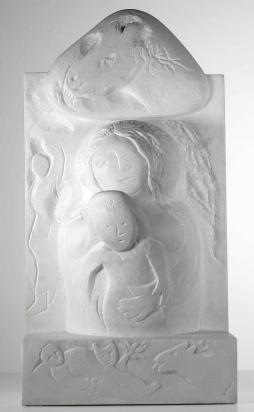This marble sculpture, Madonna with Donkey or Mother and Child, is the transposition of a model made of various materials, in the style of a “sculpted collage”1. To create the model, the artist repurposes a porcelain insulator and a stone decorated with a horse or donkey as elements of composition. Chagall’s sculpted works include several of these objects, shaped by nature and used as a medium for ornamentation. However, only two models, made exclusively or partially of these stones, are known to exist in the artist’s body of works, despite the fact that he began sculpting in the early 1950s.
Marble, an ages-old medium with a light, luminous color, gives the work an understated feel and a more solemn appearance. The mother carrying her child harks back to the Virgin and Child, but also to motherhood more generally. These themes recur in the artist’s works (Madonna with Child [Madone à l'enfant] (1911), Motherhood or The Bath [Maternité ou Le Bain] (1914), Christ and Virgin With Child [Le Christ et la Vierge à l'enfant] (1952)), as proven by the rounded volumes and nudity of this figure. The upper portion of the piece, a triangular shape with rounded edges (taken from the natural shape of the painted stone in the model), could suggest a halo or the divine protection of the chuppah, the canopy featured in traditional Jewish weddings. The various incisions in this smooth material form figures, animals, and botanical patterns in the stone at the base, bottom, and on the rounded shape. This evokes Parietal art and gives a more archaic and primitive appearance to the sculpture. The formal appearance of the piece and the composite character of its model evoke the composition of a sculpture depicting a sitting god crowned by a seashell (Tii with a Shell or Idol with a Shell, 1892-93) by Gauguin2, to whom Chagall paid tribute with a 1956 painting (Homage to Gauguin [Hommage à Gauguin] (1956)).
As a whole, the work reveals the diversity of the artist’s sources of inspiration. Like other artists, such as Picasso and Miró, Chagall delved back into the origins of humanity and art. The various iconographic elements—secular, religious, or characteristic in Chagall’s work—speak to one another in a staged scene typical of the traditional ex-voto3, giving this piece an eminently personal yet universal dimension. As stated by Jean Cassou in 1926 in the journal Cahiers d’Art about prehistoric Parietal paintings, “In the Paleolithic era as in our times, art brought freedom and a direct, simple way of knowing things that must be called truth4.”
Sculpture

